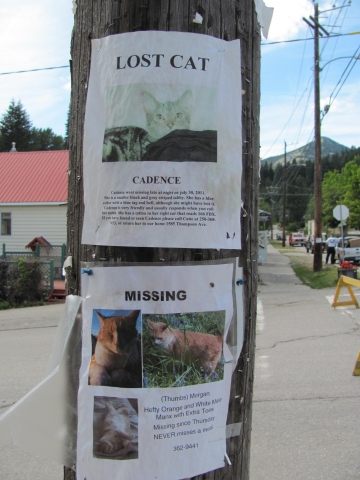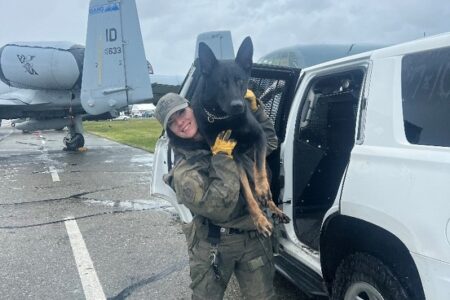Why, oh, why, Wile-E? Local cats fast becoming a favourite snack for area coyotes
If you’re like me, a cat person who does a lot of walking around town (not with the cat, obviously), you might have been noticing an awful lot of missing cat signs posted on telephone poles and community bulletin boards. It seems that every few days, there is a new sign up announcing another vanished cat. Pickles, Thumbs, and Lily are just some amongst many beloved four-legged feline friends who have never made it home after roaming about doing what cats do in the great outdoors.
Over the summer, it seems as if the appearance of these sad missing posters is on the increase, and a recent thread on Bhubble has posited a theory: Wily Wile E. Coyotes might be to blame.
Coyotes are on the hunt, and their favourite snack just might be your fluffy little purring machine.
Anecdotal evidence points to estimates of anywhere between 20 and 60 cats in Rossland going missing over the past months, and there have been several coyote sightings in town which point to increased coyote activity in the area. The conservation officer responsible for Rossland, Blair Thin, has himself fielded only three coyote reports within city limits since January, two of them coming in the last month. One included a couple who had witnessed two coyotes stalking and hunting their cat–and capturing the pet right before their eyes.
One Rossland resident posted the following to Bhubble: “I was heading to work early one morning, and saw TWO coyotes around Angela’s Guesthouse. They immediately ran in opposite directions.”
In the wild, coyotes hunt solo, in pairs, and sometimes in small packs, and they typically like small animals like rodents and rabbits. Cats and small dogs are also likely victims. If hunting in pairs, as mentioned above, coyotes will split up and stalk prey from opposite sides, tiring the prey out and making it easier to capture.
Angela Price, the proprietor of Angela’s Guesthouse and Angela’s Bed & Breakfast, both located in lower Rossland on the banks of Trail Creek, herself the proud owner of four kitties, hasn’t seen any coyotes herself but has heard through her network of Mountain Kingdom friends and neighbours of an increase in reports of missing cats in the last year.
Doreen Butler, who lives on lower Esling Drive, near the old Wagon Road, has seen coyotes in her yard. “I saw one early, early one morning, and he was between my house and my neighbour’s house, and he was walking up towards Thompson Avenue. Another close neighbour saw one quite recently when she was out walking her dog, and she said it was with a second, younger coyote. And my daughter saw one coming up the Wagon Road one night when she was coming back [home], very close to Irwin Avenue.”
Shortly after seeing the coyote in her yard, Butler’s newly-adopted cat, went missing.
Conservation Officer Blair Thin encourages Rossland residents to report coyote sightings to the RAPP (Report All Poachers and Polluters) hotline in order to give local COs a better picture of coyote activity within city limits.
“We need to find out where they’re actually hanging out and if there are certain areas that they’re targeting, when they’re actually coming out, and that sort of behaviour. Three reports in the year isn’t giving us a case history on anything.”
Thin also said that he has heard a rumour that there may be people feeding coyotes in Rossland. This is a huge no-no.
“Section 33.1 of the Wildlife Act dictates that it is against the law to feed wildlife with the intent of attracting wildlife to your land. So, in other words, leaving or placing food on your land or your premises that could attract wildlife is an offence.” Thin hasn’t been able to confirm this rumour and has no suspects.
He goes on to say that one of the major causes of increased coyote appearances in towns and cities is humans feeding them.
“Coyotes are prone to becoming conditioned and habituated–much like the wolf or the fox–very quickly, more so than a bear would. They get very accustomed to being fed, especially hand fed. We’ve had a huge increase of wildlife encounters along our corridor in the rest areas. People pull over on the side of the road and they see a coyote sitting there, or a red fox, or whatever, and they throw it a Tim Bit or something like that. That only needs to happen a couple of times before animal realizes ‘wow, I’m getting some good meals just sitting here looking cute and forlorn or trying to pretend that I’m hungry’.”
Butler suggests this: “Something must have happened with the rabbit population. Normally, nature provides accordingly, but obviously something has unbalanced the rabbit population at the moment, and when the rabbits are back they the coyotes will be quite busy and they won’t be coming into town.”
But whether it’s an imbalance in Mother Nature or a family of Wile Es being their natural, opportunistic selves and capturing whatever’s bountiful nearby, the only sure way to keep your kitty safe from becoming a coyote’s next meal is to keep him or her inside, particularly at night and in the early morning, when coyotes are most active.
“I’m all for live and let live,” Angela Price states, “but not when some thug of a [wild animal] moves into town. You can’t blame a coyote for being hungry, but you can say enough is enough when something is obviously hunting pets.”
With all this in mind, please report any coyote sightings in town to the conservation officers so they can establish hopefully cat-saving coyote patterns of behaviour in Rossland. The hotline number is 1-877-952-7277. It’s the central dispatch office in Victoria, but it is manned 24 hours a day, and the details you give the dispatcher will be quickly given to our local conservation officers.
In the meantime, keep cats indoors and small dogs on a tight leash when taking them out for walks.

























Comments